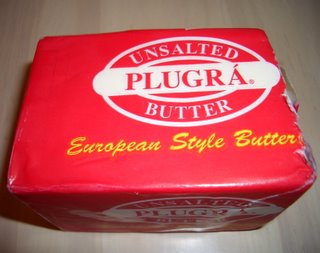Those Aren't Chocolate Chips, Those Aren't Raisins

They're olives.
I've noticed a trend recently to pair sweet and salty for appetizers and desserts (such as the blue cheese stuffed dates wrapped in bacon made popular by L.A.'s A.O.C.). Ever since I heard about a candied black olive and basil marshmallow tart that used to be served in San Francisco's Citizen Cake, I wanted to try olives with sugar.
Ironically, the recipe that I found is not from a newly minted celebrity chef, but from an old French family recipe that makes "scourtins."

Knowing this old European heritage, I indulged another lingering taste desire: Plugra butter. Plugra literally means "more fat." Excellent. I'd heard that it can revolutionize your baking. It's a European style butter that has less water than American butter so that the fat content is about 82% instead of the 80% of standard American butter. It has a lower melting point than regular butter as well as a smoother, richer texture and flavor. This cookie is supposed to be crisp, so that lower melting point would lend itself to that. A warning, though, that it comes in a one pound block without measurement markings, so I guess it's time to buy that scale you've always wanted to measure it precisely.
So, how is the cookie? Fantastic. How can I describe it? I dunno.... like olives surround by sweet batter and it tastes good. There was even a lovely sweet-savory smell while it was baking that I couldn't identify either. I though that the batter would turn a bit purple (I used Kalamata olives), but the olives stayed to themselves and a l m o s t became like silkier savory raisins. They dried out a bit and became a little chewier, but only tasted sweet as a result of the batter. A stray olive bit did not taste sweet at all.
And the batter, as a result of the plugra and the confectioner's sugar, was on the crisp side with a little bit of rich flakiness.
Pairing these cookies might be difficult... or an adventure for brave souls. I want to put a square of milk chocolate on top of one and melt it briefly in the oven to see how it tastes. The depth of the baked olives just hints at chocolate itself. Another option would be to substitute half chocolate chips to see what happens. At another point, I though that a piece of feta on top, or maybe ricotta or ricotta salata, would be perfect. Milk might be good to drink with it. Or tea. Maybe hot chocolate. Wine. Probably not so much coffee or soda. Probably not many fruits; maybe plums. I was going to add rosemary to part of the batter, but then I forgot.
Olive Biscuits
(Les Scourtins aux Olives de Nyons)
9 tablespoons unsalted butter, softened
3/4 cup confectioner's sugar, sifted
1 tablespoon extra-virgin olive oil
1-1/4 cups all purpose flour
1/2 cup cured olives, preferably from Nyons, pitted and coarsely chopped
Preheat the oven to 350°F. Line two baking sheets with parchment paper.
In a large bowl or the bowl of an electric mixer, cream the butter until it is soft and pale yellow. Mix in the sugar until blended, then drizzle in the olive oil and mix until combined. Add the flour and mix gently but thoroughly until the dough is smooth, then add the olives and mix until they are thoroughly incorporated into the dough.
Place a piece of waxed or parchment paper on a work surface, and place the dough in the middle. Cover it with another piece of waxed paper or parchment paper and roll out the dough until it is about 1/4-inch thick (the dough is very sticky, and the paper makes it possible to roll out). Refrigerate the dough for at least 30 minutes, and up to 24 hours.
Cut out 2-inch rounds of dough and place them about 1/2 inch apart on the prepared baking sheets. Gather the trimmings into a ball and roll it into a 1-inch diameter log. Wrap well and refrigerate, and when you are ready to bake, cut off 1/4-inch thick rounds (this avoids over-rolling the dough).
Bake until the scourtins are golden, about 15 minutes. Remove from the oven and cool on wire racks.
Makes 34 scourtins.
Letter from France
1999
Susan Herrman Loomis


0 Comments:
Post a Comment
<< Home